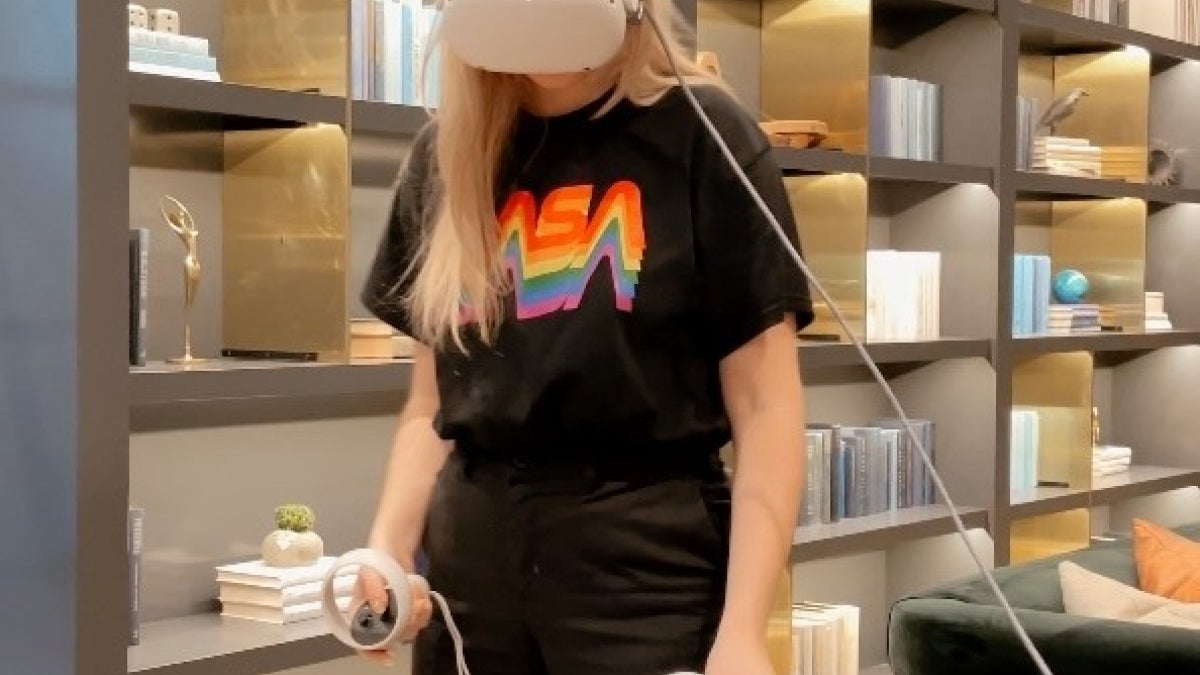Summer internship with NASA JPL was more than virtual for ASU graduate student

ASU graduate student Lauren Gold works remotely via virtual reality during her internship at JPL. Photo courtesy of Lauren Gold
Internships are a rite of passage for many undergraduate and graduate students at Arizona State University. And despite the COVID-19 pandemic, internships continue to take place, even if they have to be done remotely or virtually. This past summer, ASU graduate student Lauren Gold took her remote internship to a whole new level, going full extended reality (or “XR” for short) at NASA’s Jet Propulsion Laboratory (JPL).
Gold obtained a visiting student researcher position at JPL for the summer of 2021. Her internship involved working in JPL’s “DataSPACE lab,” which specializes in immersive technology.
She is a graduate student in the School of Arts, Media and Engineering, and she works as a researcher and developer at the school’s Meteor Studio, which is directed by Assistant Professor Robert LiKamWa, who is also Gold’s adviser. The Meteor Studio is an engineering research laboratory where students and researchers study software and hardware systems for augmented reality and virtual reality. LiKamWa also directs the Learning Futures Immersive Creation Studio, which has teams of students build prototype XR platforms for learning environments of the future. Gold is the project manager of one such team, building a collaborative 360-degree annotation tool.
Gold’s focus is XR, a catchall term for virtual reality (VR), augmented reality (AR) and mixed reality (MR). During her internship at JPL, she met with scientists and engineers from other sections to understand how XR tools might fit into their workflows and be beneficial to their needs.
During her internship, Gold had many tasks, including assisting in software development for existing data visualization software created at JPL's DataSPACE lab and helping to open-source some of the projects. She also worked on integrating various types of datasets with existing visualization tools to explore the challenges of data visualization.
Her one big project, however, has a direct connection to ASU.
During her internship, Gold designed and developed a prototype VR tool for the Mars Sample Return proposed mission. This program, whose principal scientist is ASU Professor Meenakshi Wadhwa, is in the planning stages of developing robotic systems to collect and send samples of Martian rocks and soils to Earth for analysis.
The goal of Gold’s project was to explore designs and implementations of various VR app concepts that would enable full immersion into a virtual Mars environment, and create tools and interactions for the scientists and engineers working on this proposed mission.
“The app integrates Mars 2020 Perseverance rover images, 3D terrain meshes, digital elevation models and terrain classification maps into a single shared environment,” Gold said. “We’re working to create a seamless viewing of complementary datasets, such as for those working on the Mars Sample Return program.”
JPL Data Visualization Developer Joe Roberts, who supervised Gold’s internship, said, “Lauren conducted valuable research with virtual reality tools and gained new insights about potential applications of the technology for future NASA missions such as Mars Sample Return. I was impressed by her innovative mentality and ability to connect the technology with the needs of scientists and mission planners. She came to JPL with prior knowledge and experience working with Mars science team members at ASU that made her fit right in with everyone.”
Gold credits ASU planetary scientist Kathryn Powell, who collaborated with her on VR/AR Mars projects, for helping to prepare her for this internship.
“Kathyrn was not only a collaborator, but a mentor to me,” Gold said. “She taught me pretty much everything I know about Mars science, and her informal training made it easier for me to fit in at JPL.”
Gold is also working with ASU Professor Jim Bell, the Mars 2020 Mastcam-Z principal investigator, to feed the Mastcam-Z camera system images into the VR app.
"Those of us on the Mastcam-Z team are looking forward to a great collaboration with Lauren, Professor LiKamWa and their colleagues developing these Mars data visualization products,” Bell said. “These kinds of 3D landscape models and ‘flyovers’ will be useful for scientists on the team who are working to understand the geologic context of the places we're exploring with Perseverance. Besides that — they are super cool and fun!"
Gold hopes to continue this research through 2022 and has been applying for additional funding to continue the project. Ultimately, after graduation, Gold plans to continue her visualization research, and she hopes to become a full-time “JPLer.”
More Science and technology

ASU professor honored with prestigious award for being a cybersecurity trailblazer
At first, he thought it was a drill.On Sept. 11, 2001, Gail-Joon Ahn sat in a conference room in Fort Meade, Maryland.…

Training stellar students to secure semiconductors
In the wetlands of King’s Bay, Georgia, the sail of a nuclear-powered Trident II Submarine laden with sophisticated computer…

ASU startup Crystal Sonic wins Natcast pitch competition
Crystal Sonic, an Arizona State University startup, won first place and $25,000 at the 2024 Natcast Startup Pitch Competition at…